I have returned safely from a solo backpack trip into one of the most remote backcountry areas of Grand Canyon National Park. I mentioned in a previous blog post that this would be a spiritual retreat of five days and four nights. Here is a photo from the South Rim at Pima Point:
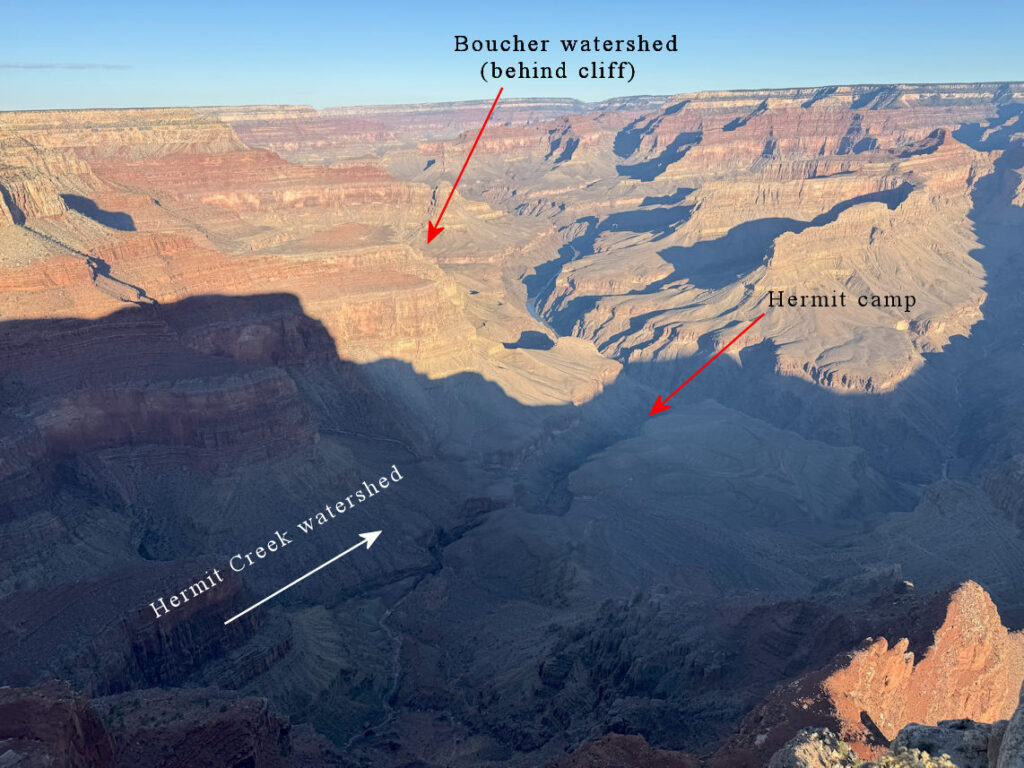
Details will follow an overview. I hiked a total trail distance of 23 miles without problems. The nights of tenting were enjoyable and trouble-free. The canyon presented beautiful vistas of rock and sky as well as close encounters with streams, cacti, wildlife, and stars. Silence reigned. Spiritually, I felt blessed to be able to think, meditate, and pray without the feeling of being in danger. The demons I expected to accompany me were never evident. I believe the lack of ability to contact the civilized world worked in favor of my not getting distracted. I took notes and had a few revelations. The thoughts and impressions will take time to digest fully, but I can provide some good stuff below.
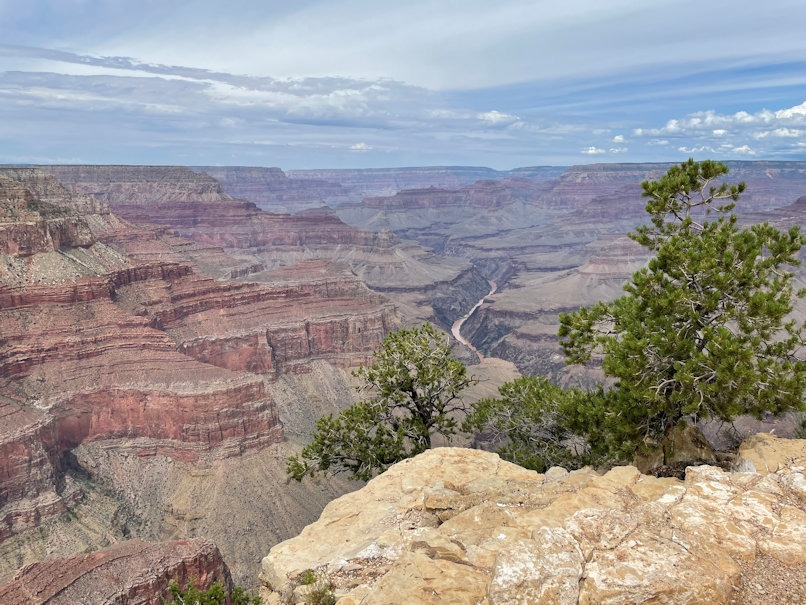
To convey details, I’ll intertwine the spiritual pathway with the physical.
Over many decades, I have frequented desert spaces. They have two main attractions. I love the beauty of the rocks and plants, finding life and inspiration in the seemingly inhospitable dry desolation and its relative emptiness of people. Secondly, even if I initially ventured to the desert to check out its beauty, I recognized and felt its impressions on my spiritual senses and vague feelings of communion between the Creator and myself. More than anywhere on Earth, the Grand Canyon gave me more explicit spiritual ideas and foundations for the kind of person I want to be.
Only after going a time or two did I remember that Jesus had been drawn into the wilderness for forty days and nights to be tested and tempted. He must have been drawn and gone willingly rather than forced. I am not saying my times have been like those of Jesus. He was a young rabbi on a mission and had to deal with his spiritual power, a power to which none of us regular humans have ever come close. I am an old man, just trying to understand better what the Creator might want of me. But the way Jesus withdrew to the wilderness says something about its value. He didn’t even have to leave his cell phone at home.
The journey of my spiritual retreat began at Hermit’s Rest, the trailhead of a rugged backcountry pathway beginning about seven miles by road west of Grand Canyon Village in the park. Below is a topo map with the trails I took. The Hermit Trail goes about 8 miles to the Hermit Creek camp. Five miles northwesterly on the Tonto Trail brings you to Boucher Creek. About a third of a mile up from Boucher Creek, the Boucher Trail intersects the Tonto. From there, the return to the rim at Hermit’s Rest is nine miles.
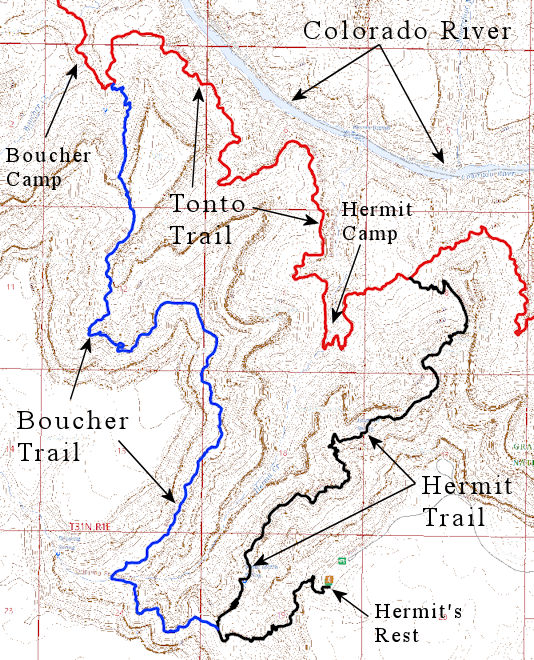
The Hermit Trail descends rapidly, with a natural rock pavement interspersed with rock steps set by human hands. Many of these drops are more than a vertical foot. In places, early trailblazers laid cobble-like stones by hand to create a relatively steep but walkable slope.
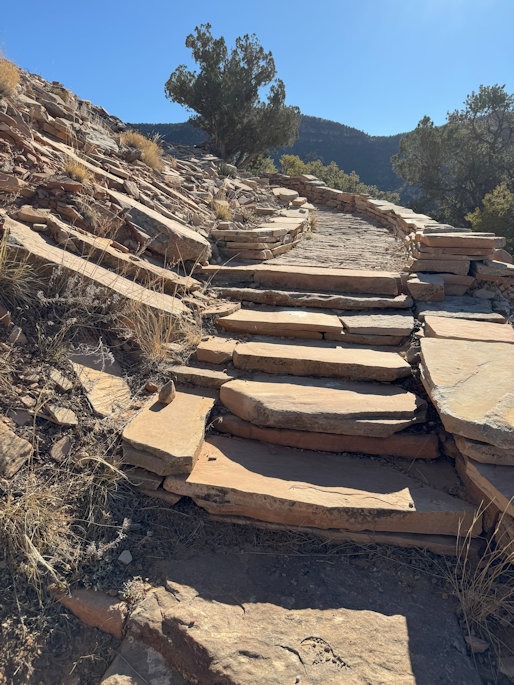
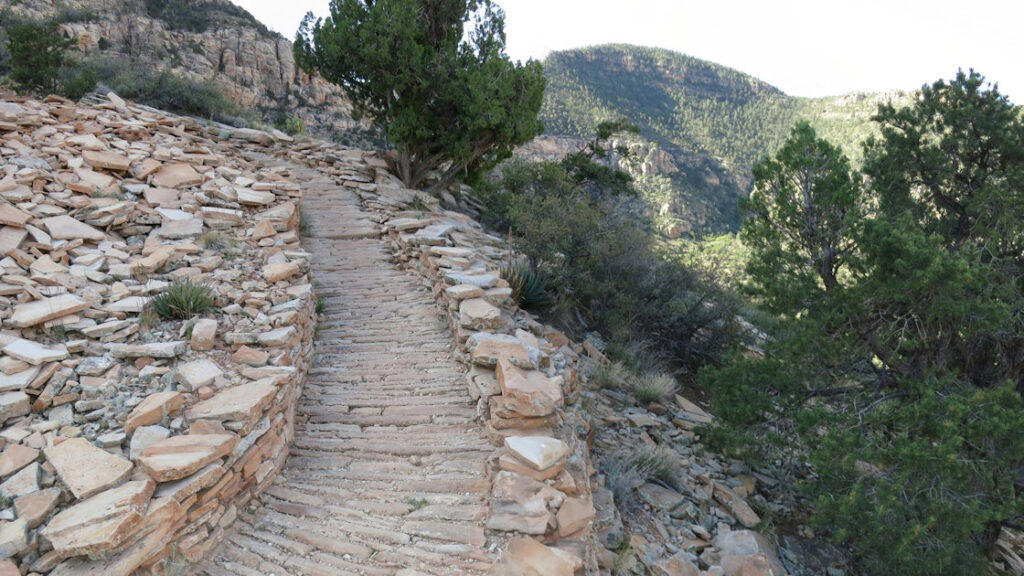
The trail was constructed by various parties in the last quarter of the nineteenth century and improved by hand through the first quarter of the twentieth century. The so-called hermit, Louis Boucher, lived near Dripping Springs off of today’s Boucher Trail from about 1891 to 1912. He intended to mine for silver but found it more profitable to lead parties of tourists. Although he lived alone he enjoyed people and was known socially on the South Rim. The left photo below shows a large stone embankment (looking uphill on the trail). The right photo is closer and more clearly shows the trail on top of the hand-laid embankment.
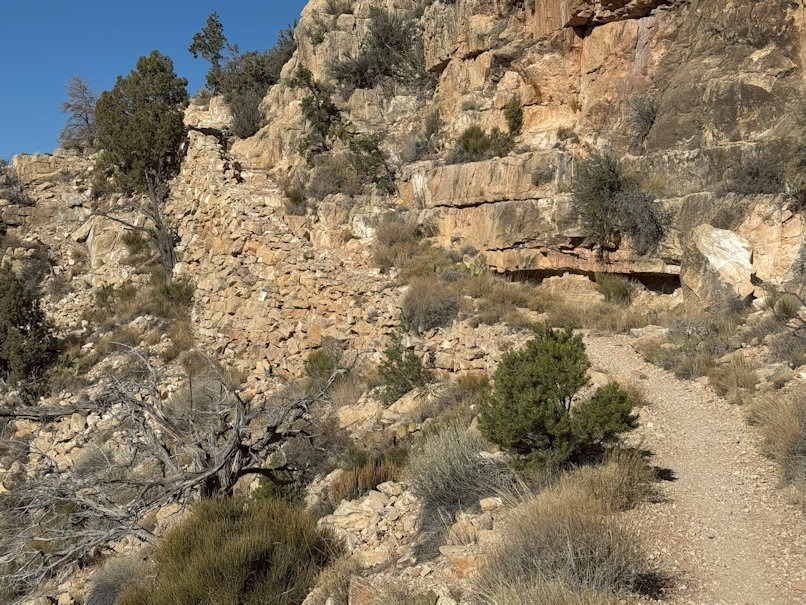
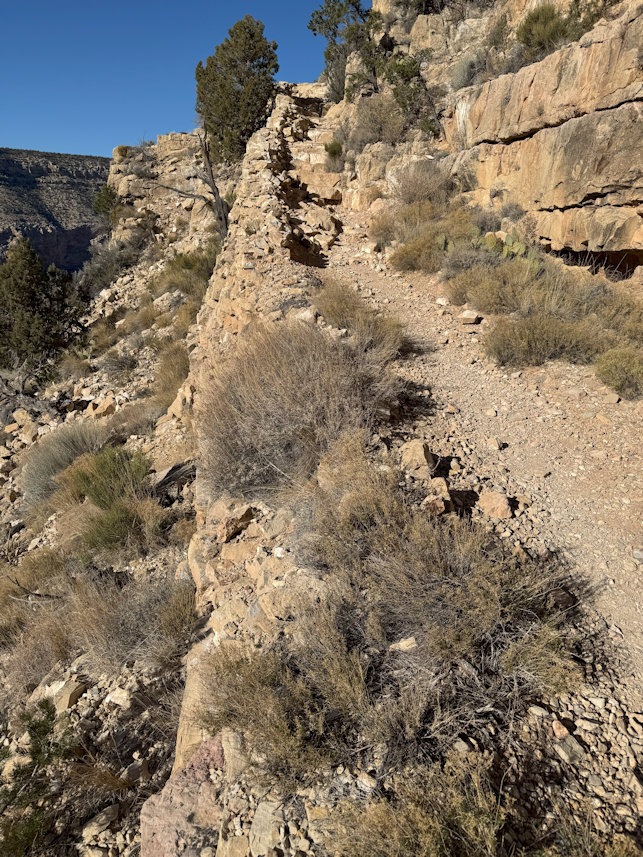
Because of the steepness of the trail and the height of many rock steps, the Hermit Trail requires strong legs, knees, and ankles. Another issue is that people often underestimate the length of time it takes to backpack a mile in the Grand Canyon. Of course, a person’s age and general fitness have a bearing. But whatever speed you can make on a flat road surface—cut that time significantly for Grand Canyon trails, especially the rugged backcountry ones. I’m sixty-eight and in pretty good shape. My knees and ankles are strong. But counting on my speed with a loaded backpack to be one mile per hour was a good general rule of thumb.
Today, it may be difficult to believe that mules could safely traverse this trail. Apparently, the old-timers sometimes took extra effort to help the mules keep traction on the steep rocks, as shown below. They would step curved irons. Tourists probably used them also.
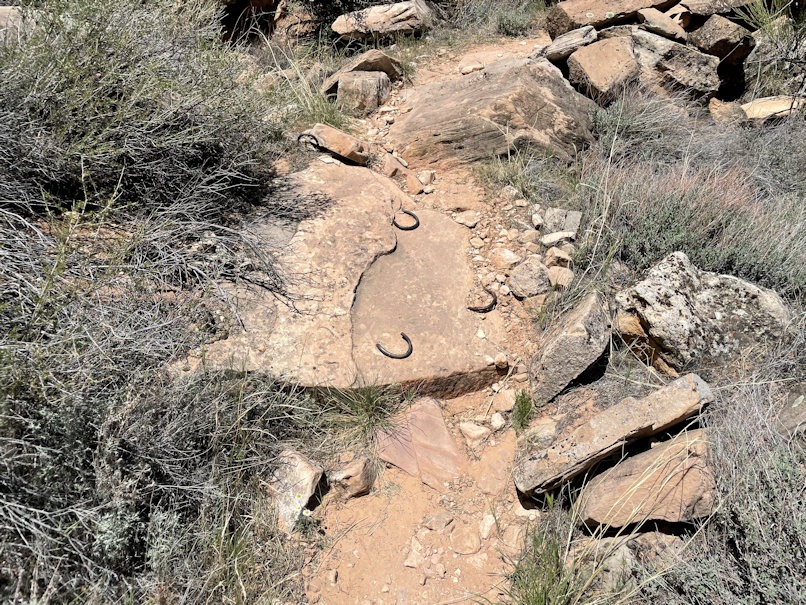
I prayed at Hermit’s Rest before starting. Often, I forget to pray about things, but this was an intentional spiritual retreat, so you’d hope I’d think of it this time. At 7:40 am on December 5th, I started down the trail, with the air temperature about 38 degrees. The clear sky verified the forecast; the weather was supposed to remain clear for my entire trip. As I descended, the demons I had invited to come along apparently decided to decline the offer since I was being so intentionally religious about it. They never showed up during my entire sojourn.
At about 2.5 miles down the trail, a shelter at Santa Maria Spring provides a nice rest stop and a place to filter water and refill bottles. From the Boucher Trail, on the opposite side of the Hermit Basin, here’s what that section of the Hermit Trail looks like (on the right is a zoom from the left photo):
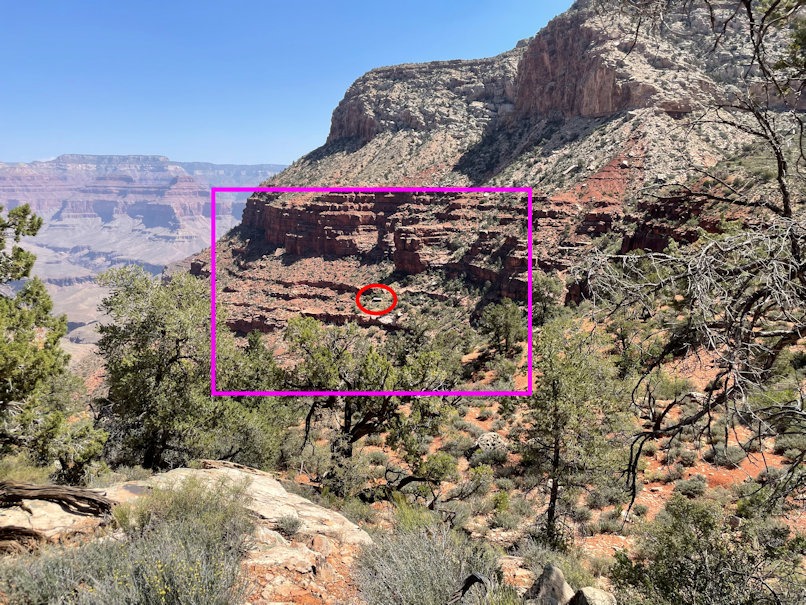
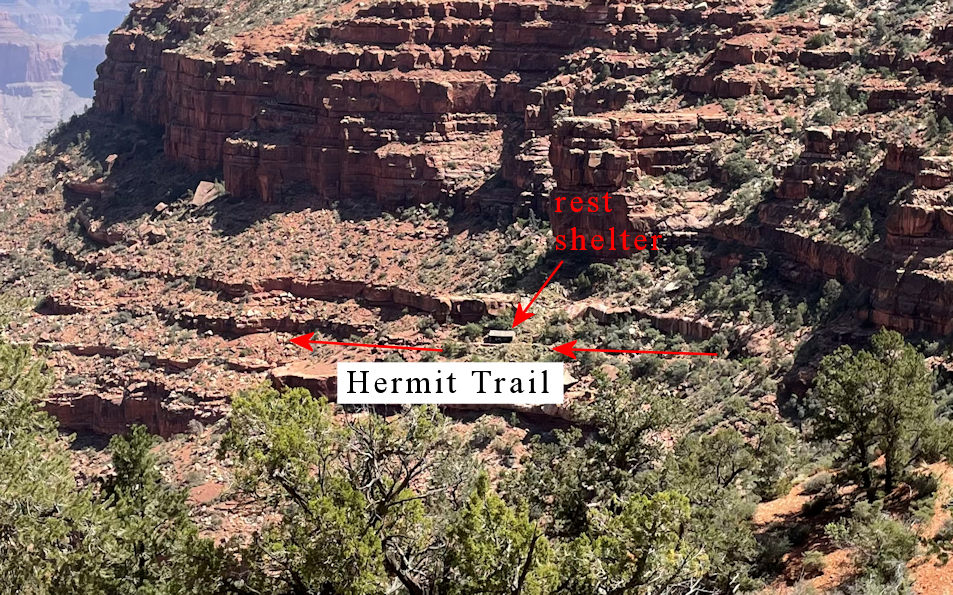
About four miles down the trail, I chanced upon a majestic creature. I came around a bend in the trail, and there, fifteen feet in front and facing me was an enormous Bighorn Sheep ram. He was an elder, for sure, since his horns curved entirely down the side of his head on both sides and back up forward. They were at least four feet from side to side. The top of his head was about five feet above the ground. Below are a couple of photos of similar rams.
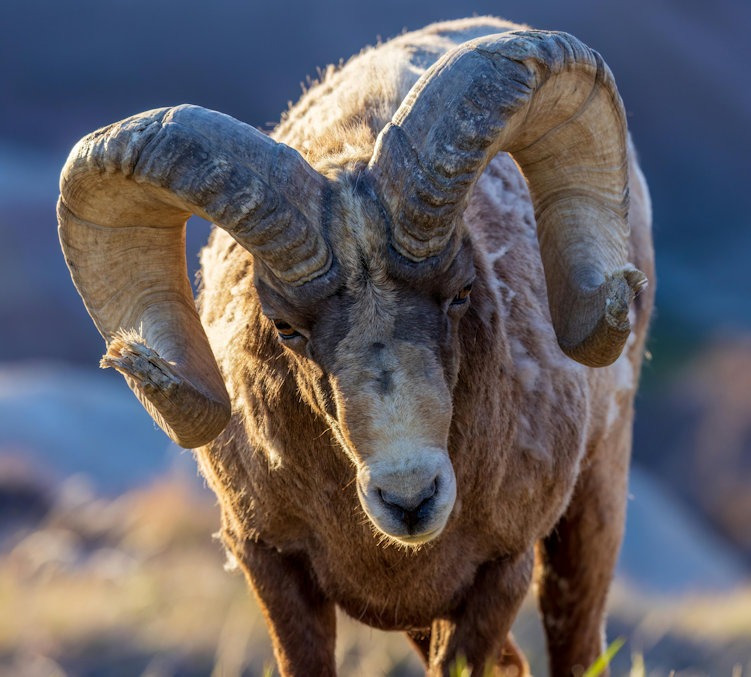
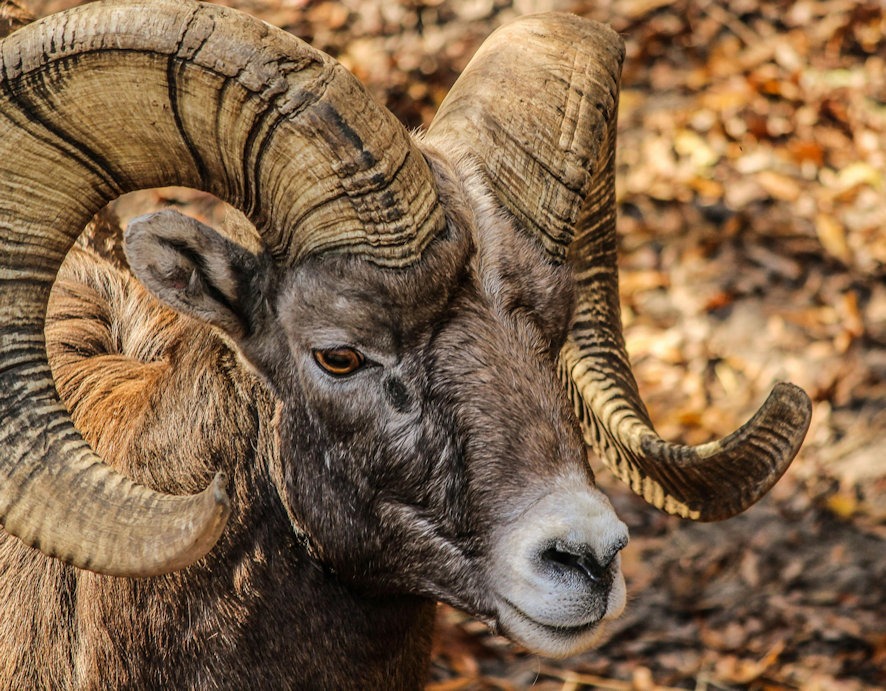
These photos are not of the ram I met, for our encounter only lasted about ten seconds. My first thought was, “Is he going to charge at me?” and I turned to lean against the vertical rock wall to my right. He decided to go around me off the trail, passing on the left, only a few feet away. When I saw him bypassing me, I tried to get the phone out of my pocket to capture a photo. No way. He was gone in a flash. I looked around the bend behind me, and if he was somewhere nearby, his camouflage hid him in plain sight.
Well… if you are Christian, perhaps you have had things happen to you that make you wonder if God had a hand in it. Who can tell? The Spirit remains a still, small voice and never makes anything obvious. But as I hiked on my way, I thought about how God had provided Abraham a ram entangled in a thicket when he needed a sacrifice to take the place of his son, Isaac. I wish I knew the Creator as well as Abraham did. Next, I thought of the story told by Luke in my novel (Luke the Lakota). He made up an Arabian Nights-type tale with impish genies. But since this was centuries before the Arabian Nights, the tale involved “ginnaye,” an Aramaic term for trickster spirits. That word and many stories from the time of Jesus were precursors for the later Arabian tales of genies and jinns.
In Luke’s story, one of these ginnaya appears to a man in the form of a mouflon and speaks to him. (This creature is from the Middle East and is related to our western Bighorn Sheep.) These sheep recollections made me think the Creator might have a sense of humor.
About six miles down the trail, I came to a section called The Cathedral Stairs. Here, the trail steepens and drops with switchbacks through high rock formations on either side, reminiscent of Notre Dame Cathedral in Paris. At the top, one can find an intriguing rock slab just before the descent. I noticed this rock when I first hiked the Hermit Trail in 1983. How could these ripples of sand on a shallow seashore have hardened and been transported to this high-elevation location? For several years after my first encounter, I did not remember where I had seen that rock, and I had failed to find it again. When my son, Aaron, came with me about five years ago, I alerted him to watch for it. His eagle eye found the rippled slab. Being at such a conspicuous location, you’d think I would have remembered it. As seen on this visit, the rock is shown below on the left. The photo on the right was from the trip when Aaron found it. The two photos were taken about five years apart. Notice that the area in front of the ripple rock has been disturbed. Could someone else know and revere this unique rock?
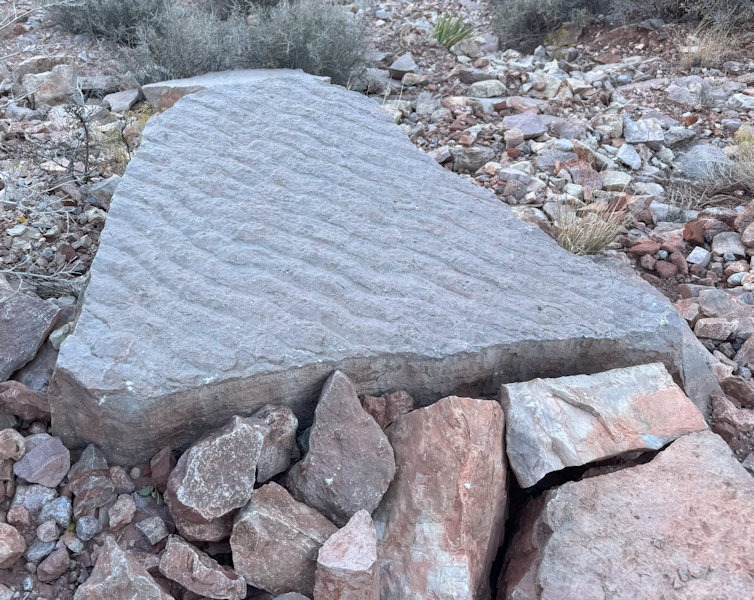
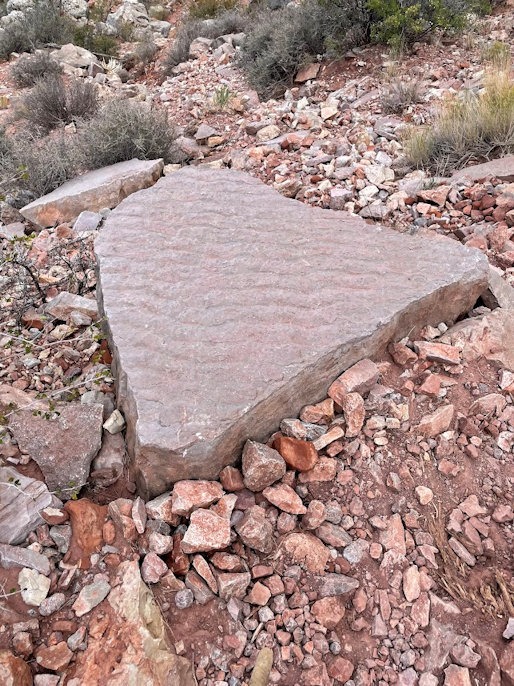
I was in pretty good shape when I reached the Hermit Camp about 3:30 pm. I had plenty of rest stops and took time to enjoy the view and take photos. But that works out to almost exactly one mile per hour. Near my sheep encounter, there was also a place along the Hermit Trail where a rock avalanche has been active, probably yearly, for centuries. It required boulder hopping and hand-and-foot crawling.
I set up my tent at a prime spot near a rock overhang and was surprised to find myself alone. Within an hour, however, two other parties arrived. The camp is large enough that we could spread out and feel secluded. That evening’s darkness and dropping temperature sent me into the tent before 7 pm. I had a book to read and a notebook for recording any thoughts. But I was worn out enough that I went to sleep before 8.
Around 10 pm, I got up to pee. The night air was probably in the 40s without a breeze. From the camp, nestled in the “V” shaped Hermit Creek side drainage, looking up, not much sky was visible. That night’s crescent moon was already out of sight. Still, the Milky Way showed its swath directly overhead. Suddenly, to my right, seemingly over the Colorado River and parallel to it, a large meteor streaked. If you think of the line made by a fine point marker pen, this was more like a triple-thick marker. Again, I thought, can this be a sign? Coincidence, sure, but I also imagined the Holy Spirit boosting mine.
The next day, both hiking parties headed out early, and I had the entire camp to myself. It would be a day of rest before heading over to Boucher Creek. I took pleasure in the silence. The air slowly warmed up and may have reached 55 degrees by noon. I could see sunshine high on the canyon cliff faces and wondered if it would come into the camp that December day. Since I have been to Hermit Creek many times in summer, I know that the sun reaches the creek well before noon, and one seeks shade to escape its heat. In winter, direct sun and heat are not an issue. That day, the sun reached camp at 1 pm. Since my tent was on the east side, it remained shaded, and I watched the line of light move toward me, finally warming me at 2:45. Gazing upward, I could see the sun headed toward a cliffside to the west. Only ten minutes later, the entire camp plunged back into shade.

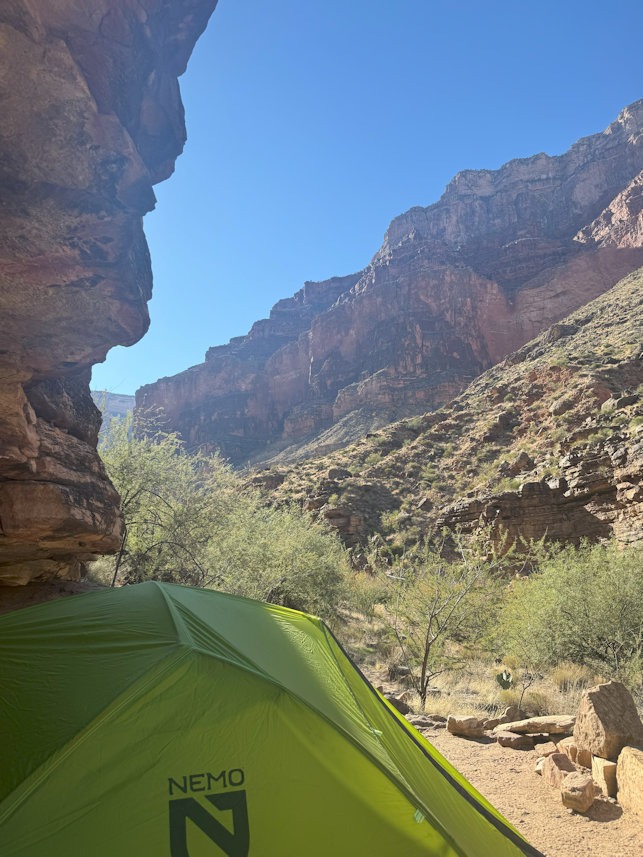
It was a productive day, spiritually. Lately, I’ve been thinking about what it means to be spiritual and what “spirit” is. See a previous post. I had already concluded that we may be mistaken in thinking of the Holy Spirit as a kind of ghost who invisibly takes up space and can be present in one place sometimes and elsewhere at other times. My Grand Canyon meditations gave me more clarity. The Spirit is everywhere continuously because the Creator has made every grain of sand, so he must know or be aware of them. The Bible says something like this.
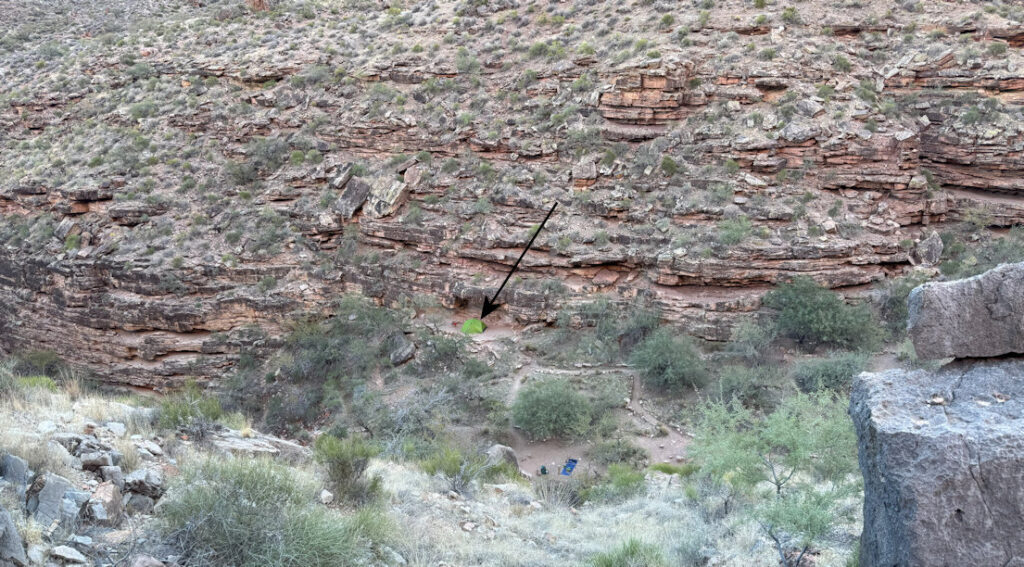
Furthermore, I sensed that the Creator designed the physical systems to run independently without his constant attendance. Yet, everything could draw his attention. Our sensing of the Spirit is not a matter of being visited by a ghostly presence but instead of drawing the Creator’s attention (because he enjoys interacting with us).
Perhaps our interaction with Earthly things causes the Creator to grant attention. Are we so unique that we should cause him to pay attention? Drawing the Creator’s attention may be part of what the scripture means that we have been “made in his image.” He loves to interact with us and maybe to observe what we do.
The Spirit wasn’t “in” the Big Horn ram or hovering around and making him come onto the trail ahead of me. But, since we ran into each other, the Spirit took the opportunity to impact me with the creature. It got me thinking about Father Zosima from Dostoevski’s The Brothers Karamazov. I had read this classic novel a while ago, and the Russian priest character’s point of view was refreshing and different from the one I had when I first considered it. Later, I learned a pastor of ours also liked the priest character. Then I discovered that Dostoevski also influenced J.D. Salinger, who wrote that Father Zosima influenced his characters Franny and Zooey.
Here’s an apt quote from Zosima expressing my spiritual musings:
Brothers, have no fear of men’s sin. Love a man even in his sin, for that is the semblance of Divine Love and is the highest love on Earth. Love all God’s creation, the whole and every grain of sand in it. Love every leaf, every ray of God’s light. Love the animals, love the plants, love everything. If you love everything, you will perceive the divine mystery in things. Once you perceive it, you will begin to comprehend it better every day. And you will come at last to love the whole world with an all-embracing love.
Zosima expresses part of what it means to love the Lord your God with all your heart, soul, mind, and strength and love your neighbor as yourself, the two commandments Jesus said were most important. The Spirit is not present in every leaf. Zosima implies that the Creator made everything with the potential to be a conduit for knowing and loving him.
I once read (somewhere) that the most fundamental manifestation of God’s grace is his creation. He made us, and the mark of his loving Spirit comes from his caring about us (as with the grains of sand and leaves). Even without being a Christian, many of us feel this place in us reserved for Spirit contact (without knowing what it is). It can give us a craving for something that seems missing, a desire for union with the unknown power behind everything. Spirituality is about beginning to see. It’s about sensing the grace and love. It’s about accepting and continuing to seek and make progress at seeing better. Curiosity and awareness are blessings from the Creator.
Zosima was part of a spiritual tradition that had existed for two millennia since Jesus, which was about seeing God in everything. The early Desert Fathers may have first held these ideas, as they knew the spiritual value of desert landscapes. Check out the Wikipedia article on the Desert Fathers.
More recently, I read the book The Solace of Fierce Landscapes: Exploring Desert and Mountain Spirituality, which fits right in with my tendencies. The author faced real tragedies, but his experiences in deserts and mountains helped him find his way.
I have not had such tragedy. But the Grand Canyon seems to serve as a metaphor. You go down first. You go down into the dangerous desolation. You face any demons who come along with you, face the fear of whether you’re going to make it back out safely, whether you planned well enough for the toughness of the environment. You also carry your inner dark side. Whatever has messed you up in life, whatever addictions you fight, feelings of failure, losses of friends, inadequacies of any kind, they come with you down into the canyon. I have sometimes felt these are given more weight by the way the canyon lets you know its indifference to your survival.
Returning to the rim in past backpack trips always causes a bit of euphoria. You survived! You did something difficult and dangerous and got back safely. Not less important, you again have good food, a shower, and a warm bed. And the cell network gives back your communication with loved ones.
Late that second afternoon at Hermit Creek, another party of backpackers came. They said they planned to return up the Hermit Trail the following day. The silent night provided more time for meditation and even better sleep than the first night. When I crawled out in the morning the others had already left. I packed up and had a relaxing time alone. I was in no hurry since I had only five miles to go along the relatively flat Tonto Trail. The camp was empty as I left it.
The remainder of my trek would be trails I had never before traversed. I looked forward to seeing if Boucher Creek would resemble Hermit Creek. Rangers said the creek flowed all year, but I would see for myself. I had made paper maps of the same type as shown above, except zoomed in for better resolution. These are the most detailed available from the USGS. But on my Tonto hike, I found them not detailed enough. What looked like major landforms in person were not visible on the maps. What on the map looked like a slight inward waver of the trail was a significant crossing of a concave side drainage. I also overestimated my speed. The five miles were relatively flat, so I expected to hike faster than the one mile per hour I had come down the Hermit. Instead, I was just as slow.
Given the not-so-great map and my overestimated speed, I thought I was much further along when I was only halfway. I thought the Boucher must be just around the next corner. I thought, “What if it goes dry this time of year?” I started to fear that the dry side creek I had just passed might have been it. Could I be headed west on the Tonto, away from where I needed to be (and into utter desolation)?
The Spirit seemed to provide for my safety. That whole day on the Tonto, I saw no other backpackers until, right in the middle of my doubting where I was, a couple of guys came along heading east. I asked if they had come from Boucher Creek, and they said they had come down the Boucher Trail but had not dropped the third of a mile west to the creek. They were headed for the Hermit camp. I asked how far it was to Boucher, and they said, “A long way yet!” They also figured the creek had water since they said they could hear it. Wow. I realized the extent of my confusion.
Along the Tonto Trail the Colorado River came into view frequently:
Easy as this hike was, I also ran into several places where I lost the trail. It would be going, for example, up a gentle slope toward a minor ridge crest, the ground all looking the same, with reddish dirt, scattered cacti, agave, small bushy things, and suddenly I would realize that I didn’t know which way to go. The only way to decipher the trail in this landscape was from the slightly paler red color caused by many previous bootprints. I had gone too far and missed a turn somewhere. The trail might climb over the small ridge ahead of me, or it might veer over toward the Colorado around the point of the ridge. I needed to back up and carefully scan the ground to see where I went wrong. The mix-up was not dangerous or scary; it just took time and vigilance. Eventually, I got back on track.
I knew from the park rangers that no trail sign marked the junction of the Boucher Trail with the Tonto. Only a cairn of rocks was said to mark the spot. Eventually, I came to an area where it looked like the trail was getting ready for a major drop into a significant side watershed, which had to be Boucher Creek. Now, I was looking for the cairn marking the trail junction while listening for the sound of flowing water. I thought it didn’t make sense for the Boucher trail to drop too much before the intersection. Why not keep it more along the ridge I had just come over?
Not too far down the slope, I encountered a pile of rocks that looked stacked by humans. I wouldn’t call it a cairn. It was a jumbled pile of stones. I took off my pack for a rest and looked around. Although it was easy to miss, possibly the steep three-foot wide bare swath across from the rock pile was a trail. I went up it, and shortly, a more obvious trail revealed itself.
Back at the Tonto junction with my pack still off, I thought things over. Here to the rim is nine miles with no water on the way. Here to Boucher Creek (the only water source) is a third of a mile and a drop of 350 feet. My trail speed is one mile per hour at best. The rangers warn that the Boucher Trail has several places where hand-and-foot boulder climbing is necessary, and the trail can be hard to find. December daylight hours would also be short. The following video is from the junction, and starts with a look up toward the gap where the Boucher Trail ascends. Then the video pans toward Boucher Creek, below. The greenish drainage is a small contributing sub-basin. Further down in the shade at the end of the video is the main channel of Boucher Creek.
I decided to spend the night at the trail junction. One relatively flat area off the trail seemed to work if I didn’t bother with the tent. First, leaving the backpack, I hiked down to the creek for water. In the photo below, I am holding the water filter pump.
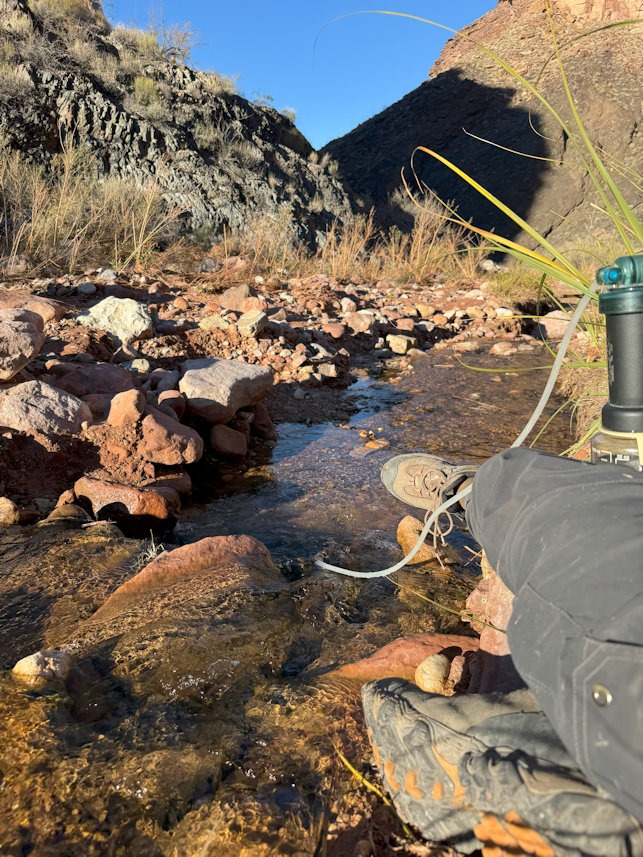
Boucher Creek has a more expansive U-shaped side canyon compared to Hermit Creek. As I headed for the water, I met only one other man camping there alone. He was happy to converse, and I discovered he was a 69-year-old German who, like me, has explored the Grand Canyon over many decades. With two full liter bottles and a bladder water bag filled with four liters, I hiked back up to where I would spend the night under the moon and stars.
The night was clear, calm, and not too cold. Being much more open than the Hermit camp, I had so much light from the almost half-moon that I shaded my eyes to sleep. Plenty of stars were still visible, but I did not recognize any constellations until I woke around three a.m. The moon had set, and Orion had rotated into view.
I might have felt some fear in my younger days, lying alone in a desolate landscape. But tonight, I was comfortable and continued meditating on the Spirit. One more quote from Zosima is worth sharing. In the Grand Canyon, you have the chance to be fully present. That includes being nothing more than who you are and facing everything you’re dealing with. It is essential to be authentic and not fool yourself. Zosima says:
The Important thing is to stop lying to yourself. A man who lies to himself and believes his own lies becomes unable to recognize the truth, either in himself or in anyone else, and he ends up losing respect for himself as well as for others.
The Grand Canyon is like an enormous cathedral that allows you to be yourself and come out from hiding to be with the Creator.
That morning, I arose as soon I had light enough to have breakfast. Not knowing the challenges ahead, I wanted an early start. It would be about two miles up to the saddle of Whites Butte but would include boulder climbing through the Redwall limestone section. Here’s a photo looking back before I had gone very far from the night’s resting place.
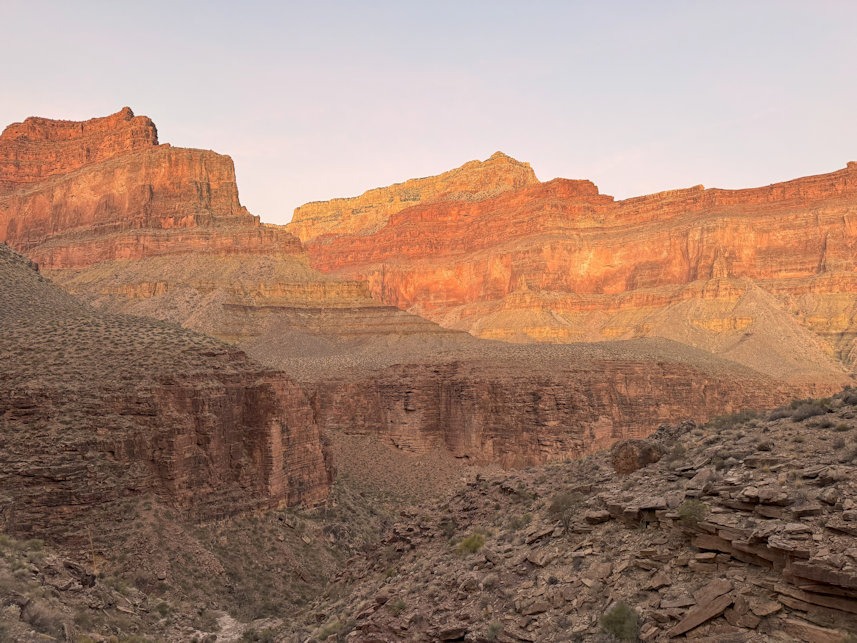
With the additional water, I had more weight than any other time during my trek. But I hand-carried the four liters in the bladder bag to give my back a break. The boulder section was significant but not hazardous. However, I did lose the way about halfway through. Boulders do not reveal where previous boots have been. With careful examination, testing whether to climb one way or another, I finally found spaces between the boulders where partial boot-prints were visible on the soil. (Yet, I asked myself, “How do I know these hikers weren’t going the wrong way?”)
Here’s what the redwall limestone looks like. (That’s the black water bladder bag.)
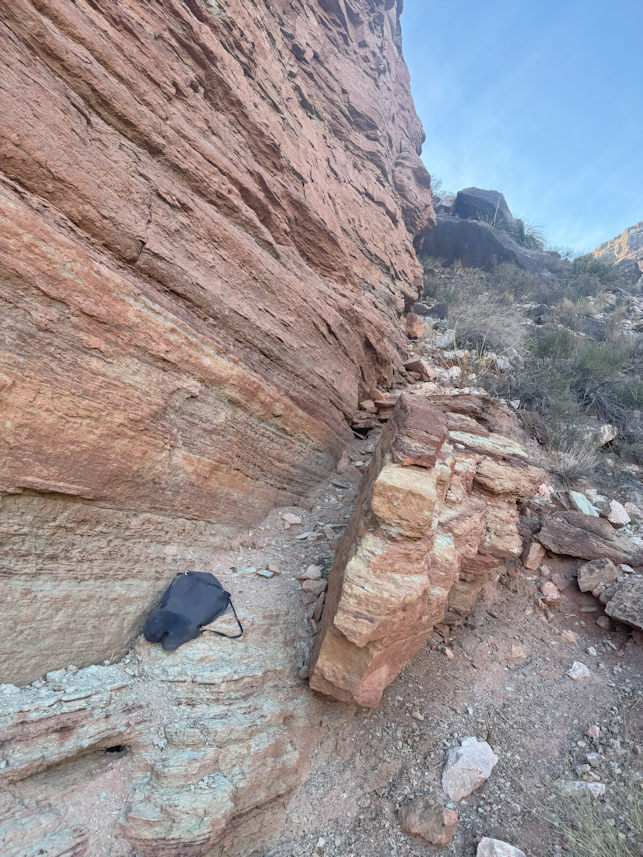
From that Redwall section, here’s a photo looking back down toward Boucher Creek:
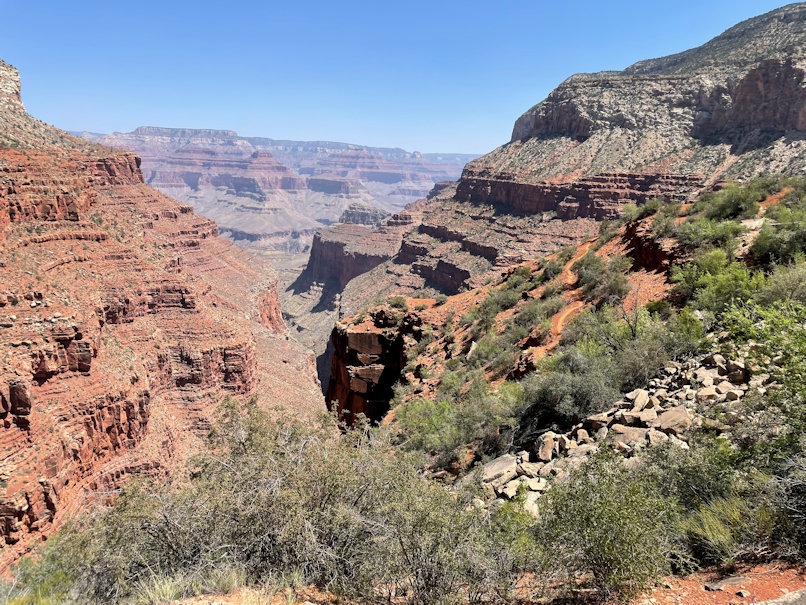
I made it to the Whites Butte saddle surprisingly efficiently, maintaining the one-mile-per-hour rate. The saddle was wide, relatively flat, and sage-brushy, and I was surprised to lose the trail again. The USGS topo map was not detailed enough, but I could see the back wall of the Travertine Canyon ahead to the right. I knew the trail would not descend off the saddle (much) before it took its way along the back wall of the canyon. Although trail-finding can be disconcerting, the best advice is to stay calm and trust that things will soon become apparent. Eventually, I again found boot-prints that gave me confidence I was on the right track.
The Boucher area does not have a designated camp but allows the choice of staying near the creek or camping along the Boucher Trail on the way back up. I planned to see how far I could get. I thought Yuma Point would be reachable since I had already attained the butte saddle. Yuma was said to be a good camping spot, and it would be about halfway to the rim and past the most challenging sections.
It would take until 4:15 pm to reach Yuma Point. I had to climb two more steep boulder sections, but eventually, I was high enough to see broad vistas. I set up the tent and gazed at the classic American Southwest pastel colors all around.
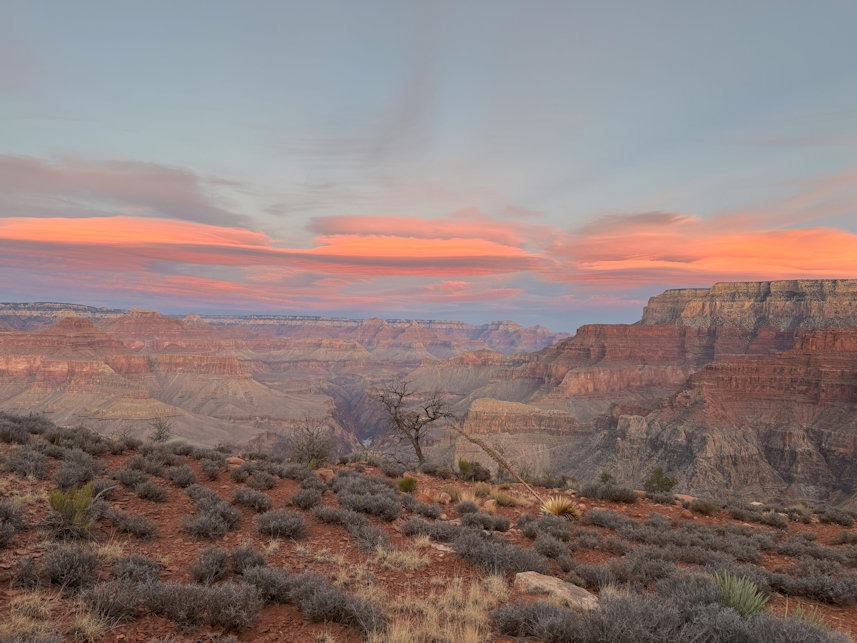
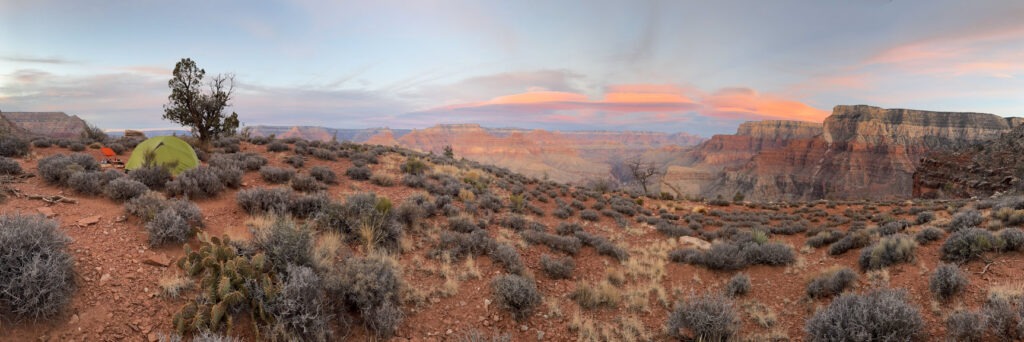
The night at this higher elevation spot was not much colder, maybe in the upper 30s, but it was mysteriously windy. I’ve experienced before in these mid-elevation locations that the Grand Canyon air masses are chaotic at night. In summer, the air temperature varies extensively between the rim and river. At night, the warm air from the inner canyon often suddenly rises, blows hard for an hour, and then quits just as abruptly. In winter, the temperature difference is less varied. This entire night was billowy off and on. Only at sunrise did things calm down.
Unlike my previous mornings, this open area provided plenty of pre-dawn light before the sun rose over the rim.
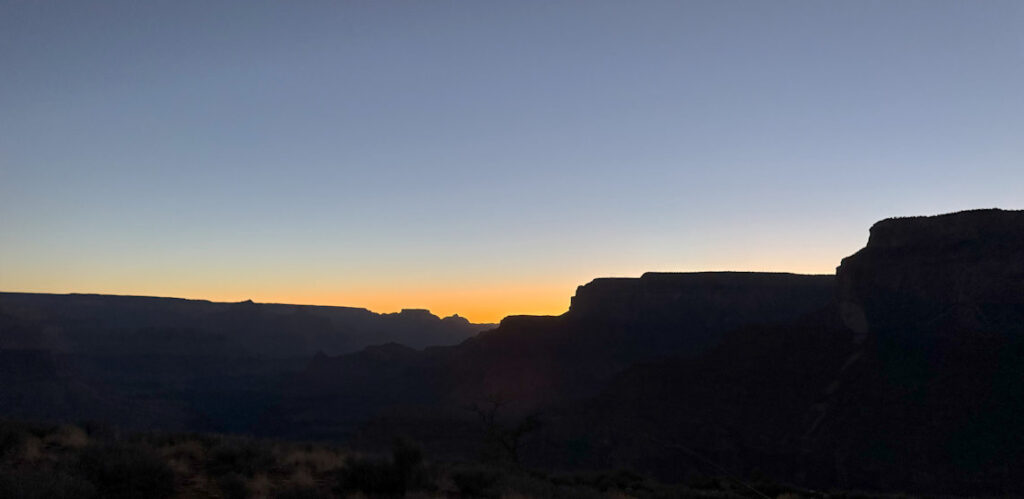
The time of the above photo was 6:55 am and that of the photo below 8:20. I started the day’s hike just before 9.
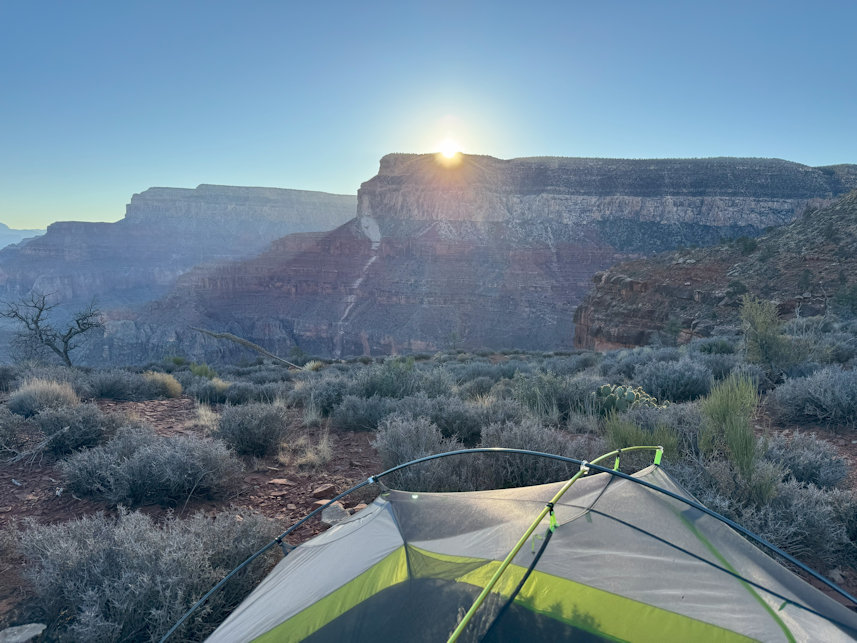
Although my spiritual musings might require much more time to digest, I thought about my experience to this point on the trail. Love of every created thing was key, including animals, seemingly insignificant plants, and even inanimate objects. But how should we act out this love? Not by picking up a few dirt particles and declaring their beauty and importance. As far as most things go, we should remember to treat them reverently, being part of the Creator’s work, but not act as though they are people or have a ghostly spirit.
Yet, gaining a habit of treating all things with reverence might help us with people. Some humans are easy to love and respect. Others, not so much. Jesus calls us to love the less lovable people and even those we consider enemies. Introverts like me don’t necessarily want to have many close relationships. We can love people from a distance. However, we should not disregard them. Perhaps I learned here that the Spirit may impact us through people encounters similar to my ram encounter. While the Holy Spirit will not shout, “Pay attention here!” the Creator charges me to be vigilant about possible depth of meaning in any encounter and actions called for at any moment.
Below is a view from the trail not far from Yuma Point toward the Colorado River. The trail continues to the right, coming into the Hermit watershed.
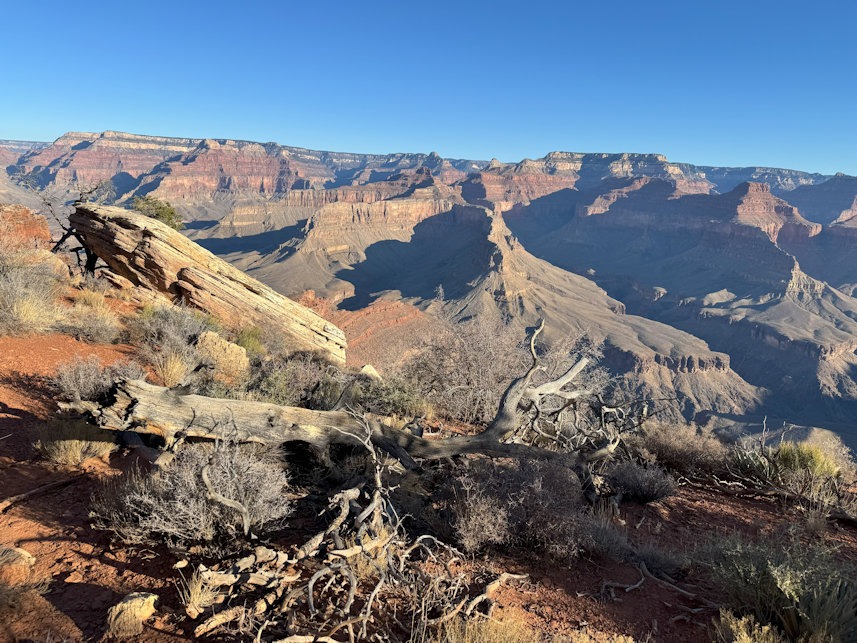
A little further, we see the Hermt watershed from the Boucher Trail side:
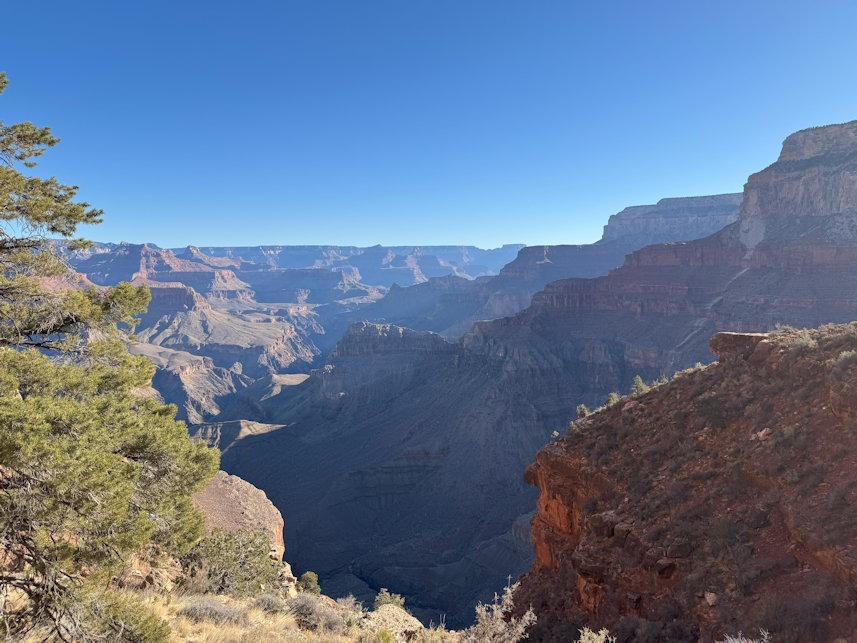
Compared to yesterday’s steep boulders, much of this day’s hike was relatively steady elevation for about three miles, until meeting the Hermit Trail again and the final climb back to the rim.
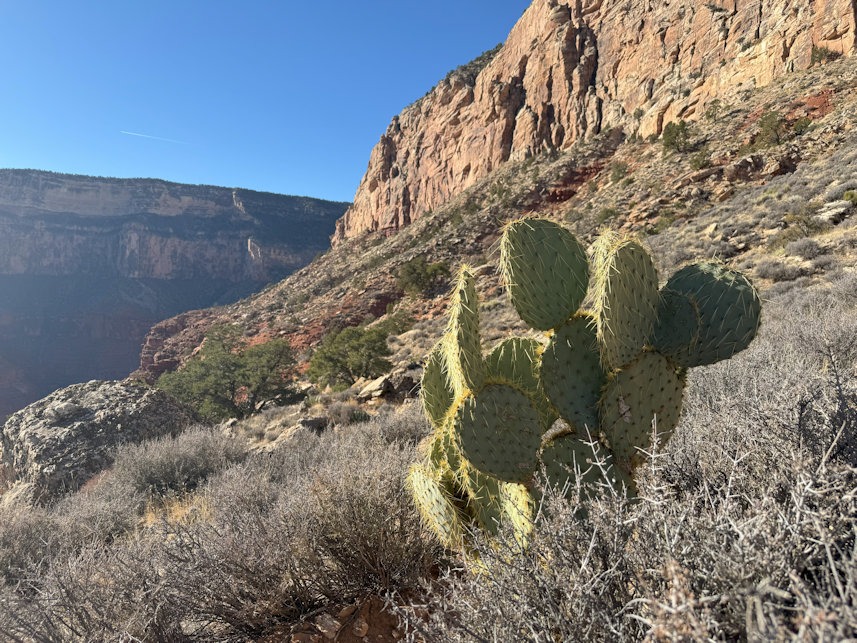
During the two days of hiking up the Boucher Trail, I encountered no other hikers until several hours beyond Yuma Point. A young man ran on the trail toward me with no backpack. He wore running shoes and carried a small plastic store-bought water bottle. In his hurry, he told me the day’s route was down the Boucher, over to Hermit Creek on the Tonto, and back up the Hermit. I suggested that it was ambitious for one day, and he replied that he intended to complete it in five hours! (Remember, that was the same time it took me to trek across the relatively flat Tonto between the two creeks.)
Off he went, and I thought he was crazy. Climbing up those three boulder sections on the Boucher was difficult enough. I thought it would be even more challenging going down. He would have no more water than his small bottle for the next 14 miles until Hermit Creek. He was probably almost four decades younger than me, so what did I know? Yet, if he went slower than expected and the sun went down on him, he would have a dangerously cold night.
I finally reached the trail to Dripping Springs, where Louis Boucher had lived. The spring is close enough to the rim that many people make a day-hike of it. Being only a half mile from the junction with the Boucher Trail, as shown below, I could have gotten water if needed. But I was still in good shape. The photo is looking back down the trail. I had come up the Boucher (on the right).
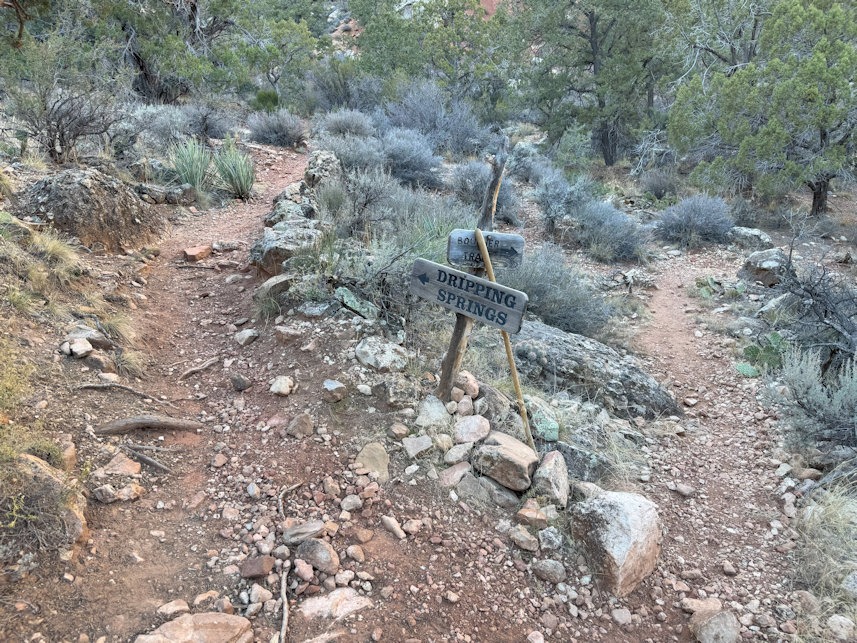
I day-hiked to Dripping Springs a few years ago, and here are photos from back then:
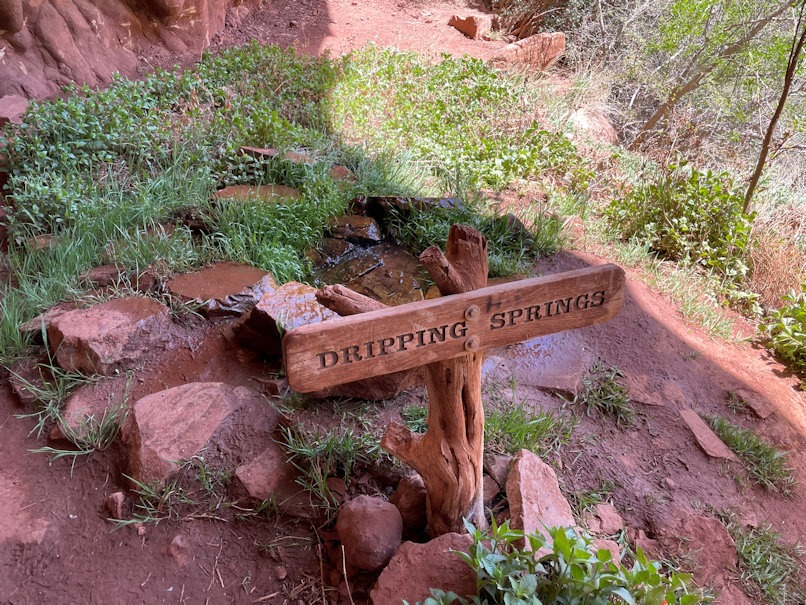

I was almost back to the junction of the Boucher and Hermit trails. The following video gives a sense of the upper Hermit Creek watershed:
The last mile would be another steep climb back on the Hermit Trail. I took time and rested frequently. A particular rock in this section is a long-time favorite. As shown below, it is a convenient cube shape, perfect for sitting while wearing a backpack.
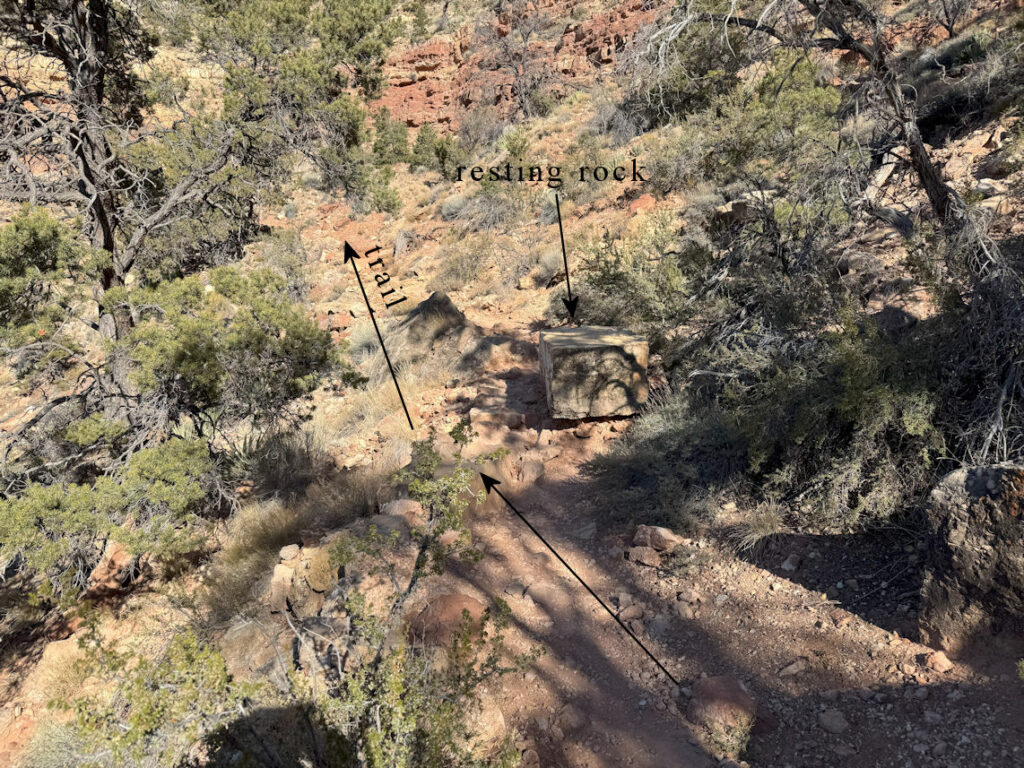
Here’s a video of me sitting on that important rock, which I have visited many times:
Almost back to the rim, I was greeted by a young female backcountry ranger headed down the trail. We chatted for a while. I first asked if she was Betsy. She laughed and said no but is often told she looks like Ranger Betsy. I explained that once several years ago, Aaron and I were camped at Monument Creek, and Ranger Betsy came by after dark and talked to us. We had a pleasant chat but were all in the dark so I had no idea what she looked like.
I also told this ranger about the young runner that had passed me. I said he seemed crazy and asked if she would be worried about him. She said the rangers have noticed an increase in these trail runners lately. Many are exceptional in their endurance, but many people also underestimate the backcountry trails. Since she was headed down the Hermit Trail, I suggested she keep an eye out for this runner. If he were anywhere close to his intended timing, she would run across him up ahead.
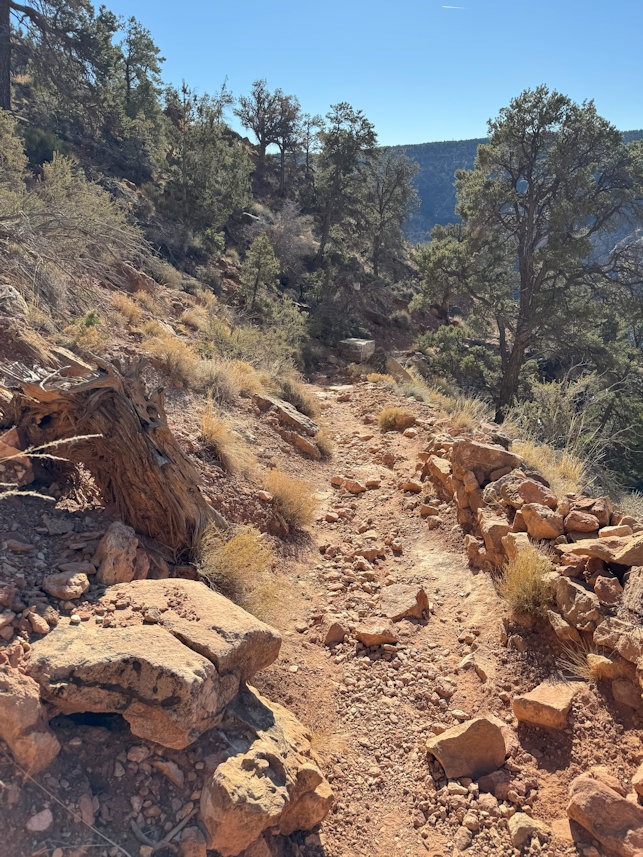
I don’t know how that turned out, but at least I put the guy on the Rangers’ radar. Above is one last view of the upper Hermit Trail.
As I approached the rim, I felt a few spiritual conclusions come to me. I wrote above that spirituality is about seeing, about being curious and aware. Yet, we humans so easily forget our vulnerablity to pride. Seeing clearly requires humility. Jesus warned the Pharisees about the dangers of thinking we know what it is all about. Maybe that young runner was about to pass me, coming up to Hermit’s Rest! I would have been astonished. But the canyon had already shown me several times that I could be misled. I learned not to go too far down a way with diminishing signs of a trail. I might be off-track! The spiritual person tries to see while at the same time living with uncertainty in our perceptions.
I reached the rim at 3:15 and thanked the Creator for a safe and productive journey. Wasting no time, I stashed everything in the car and headed back to civilization. The Yavapai Tavern provided me with a most satisfying elk burger and an IPA beer.
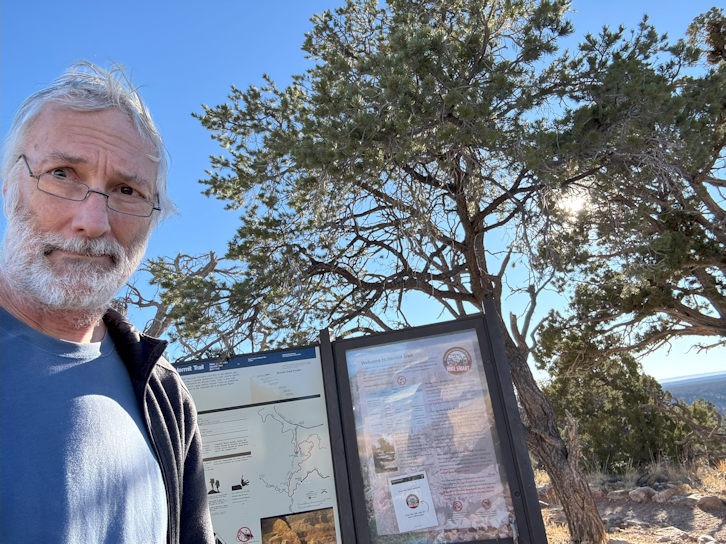
That evening, I drove to Page, Arizona, and booked a comfortable hotel room. It had been another wonderful visit to The Grand Canyon. I will sign off with one more amusing tidbit. Taking a shower that night, I discovered several cactus spines poking out of my lower legs. These were mysterious, for they were not the sharp, stiff, straight spears often associated with cacti but were flexible, like hairs. How could these have penetrated my pant legs and poked me without my knowledge? They were not easy to pull out, either! For some, I figured I would let them fall out on their own.
1 thought on “Going Down Willingly”